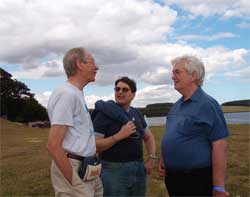What Has Happened - A Brief History Lesson
Lots of folks have no sprites or ghosts or deities in their thinking about reality; no life after death hopes for themselves or loved ones, and no supernaturalism at all in their worldviews. Why are they marginalized at the sidelines when they should be as central as anyone to political decision making?
This movement began with a desire to do something to facilitate more people who have a naturalistic outlook getting into the civic mainstream and to address the sorts of societal factors that keep so many out action (or feigning beliefs they do not have, or evading associations that they do).
We thought to try to unify large numbers of diverse people with a civic umbrella term so that more people might begin to express themselves within their spheres of activity.
- Co-Director Paul settled on bright (n.) as that term (October 2002), and later Co-director Mynga generated its definition: “A bright is an individual who has a naturalistic worldview, free of supernatural and mystical elements.”(November 2002)
- We bounced the overall idea off of others (January through April, 2003), and after getting feedback, soon set up an online website and then established a formal legal organization (June 2003; August 2003).

Paul actually meets two Forum Facilitators in person while in Edinburgh, Scotland this summer
- Other people joined in, and a Brights Forum developed (December 2003), to be run by dedicated Brights from different nations. The Forum operates round-the-clock with discussants from across the globe.
- Brights Central (BC) started cranking out Brights’ Bulletins monthly, polling Brights and responding to constituents and queries, adding information to the “home-brew” website, and sending out occasional “BrightenOps” (opportunities to take an action). Later came occasional regional announcements (e.g., emailing to Brights within 50 km of Geneva).
Notice: Paragraphs below close with italicized comments related to current or recent activity. The link will let you zero in on such activities. You can follow a link someplace else to take a closer look. But, be sure to come back! You can use your back arrow to return. If you get totally lost return to your email and restart.
- Brights Meetup gatherings came onto the scene (and sometimes departed). The largest currently is in London, England
- Other “Brights sites” - created wholly by volunteers - sprang up in several languages. A new German language site is being launched this very month (under construction)!
- Brights Local Constituencies began communicating. The current listing includes 27 groups.
- With polling and creative input, an icon was selected and a logo developed. With the help of a volunteer Web architect Theo, the main site became more attractive, accessible, and functional (Spring, 2005). This symbolism page illustrates aspects of the more professional look and feel. http://the-brights.net/vision/symbolism.html
- BLC activists put up focused websites and started stirring interest o n the part of youth. Brights now have a presence in Facebook and at MySpace. CivilBrights.net is a student-run site.
- Some individual offshoot Web efforts took place. The new www.BrightsOnline.org site has started up a Frapprmap and a Brights’ Webring.
- Finally, after many requests, arrangements were made to have Brights merchandise. Now you can deck out postage stamps with the icon, and the logo appears on items from totebags to lapel pins to Tshirts available in The Brights Shop.
- All along, the movement has received sporadic mention in varied publications and web resources. While some articles about the Brights movement get it right, many have called for a response, such as this article Shedding Light on Brights by the Co-directors.
The Brights have come a very long way in four years! BeliefNet just last month acknowledged this movement, naming the Co-directors in its “Who's Who” of freethought today.
We’re far from our original dream, but we have momentum. Keeping it is, in part, up to you.